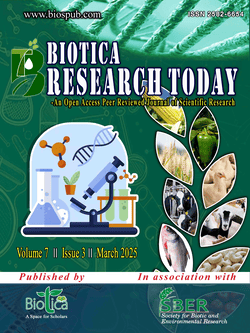
Unlocking Chitin from Shells: Extraction, Properties and Applications
Pallavi Bhalavey*
College of Fisheries, Chaudhary Charan Singh Haryana Agricultural University, Haryana (125 004), India
Krishan Kumar Yadav
College of Fisheries, Chaudhary Charan Singh Haryana Agricultural University, Haryana (125 004), India
Nidhi Dhansukhbhai Patel
College of Fisheries, Chaudhary Charan Singh Haryana Agricultural University, Haryana (125 004), India
Sneha Chaudhury
College of Fisheries, Shirgaon, Ratnagiri (DBSKKV), Maharashtra (415 629), India
Rishi Pal Yadav
College of Fisheries, Chaudhary Charan Singh Haryana Agricultural University, Haryana (125 004), India
DOI: https://doi.org/10.54083/BRT/7.3.2025/86-89
Keywords: Chitin, Processing waste, Shrimp biopolymer, Sustainable extraction methods
Abstract
The abundant chitin biopolymers are the most promising and prevalent polysaccharides that exhibits in numerous roles because of their distinctive characteristics. It is applicable in various fields from biomedical sciences, agriculture, food, pharmaceuticals and waste management techniques. The shrimp shell waste is the promising sources for chitin polymers and this shrimp shell waste accounts for nearly 45-48% among total shrimp’s waste. This waste consists of several substances such as chitin, proteins, calcium carbonates and some bioactive compounds and this holds a significant untapped potential to utilize it for various industrial applications. The extraction methods primarily involve chemicals that rely on harsh reagents, contributing for environmental pollution. However, biotechnological methods employ microorganisms or enzymes to ensure a sustainable extraction procedure. These biological methods face some challenges in terms of efficiency and time consumption. This hidden potential of shrimp shell waste can contribute to enhance economic growth, innovative biomedical applications and environment sustainability.
Downloads
not found
Reference
Anonymous, 2024. India’s seafood exports touch all-time high by volume in FY 2023-24. In: PIB. Ministry of Commerce & Industry, Delhi. Available at: https://pib.gov.in/PressReleaseIframePage.aspx. Accessed on: January 25, 2025.
Aranday-García, R., Guerrero, A.R., Ifuku, S., Shirai, K., 2017. Successive inoculation of Lactobacillus brevis and Rhizopus oligosporus on shrimp wastes for recovery of chitin and added-value products. Process Biochemistry 58, 17-24. DOI: https://doi.org/10.1016/j.procbio.2017.04.036.
Dhanabalan, V., Xavier, K.A.M., Eppen, S., Joy, A., Balange, A., Asha, K.K., Murthy, L.N., Nayak, B.B., 2021. Characterization of chitin extracted from enzymatically deproteinized Acetes shell residue with varying degree of hydrolysis. Carbohydrate Polymers 253, 117203. DOI: https://doi.org/10.1016/j.carbpol.2020.117203.
Gortari, M.C., Hours, R.A., 2013. Biotechnological processes for chitin recovery out of crustacean waste: A mini-review. Electronic Journal of Biotechnology 16(3). DOI: https://doi.org/10.2225/vol16-issue3-fulltext-10.
Saini, S., Chand, M., Sharma, H.O., Kumar, P., 2020. Role of Chitinases as a waste management to control global crisis. International Journal for Environmental Rehabilitation and Conservation XI(SP2), 303-313. DOI: https://doi.org/10.11208/essence.20.11.SP2.156.
